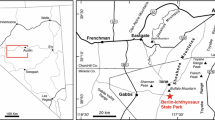Abstract
Statoblast valves produced by the freshwater bryozoan Plumatella nitens were recovered in three sediment cores from Douglas Lake, Michigan. Douglas Lake is a multi-depression lake of glacial origin. The region was heavily logged from 1880 to 1920. Sediment cores were taken from three of the seven depressions, and dated using 210Pb isotopes and pollen. Sedimentation rates were very low in the Grapevine Point core as compared to the other two cores. Concentrations of statoblasts ranged from three to 140 ml-1 of wet sediment. Profiles of statoblast concentrations and accumulation rates indicate a sharp decline in Plumatella populations corresponding to the time the Douglas Lake watershed was being clear-cut. It appears that logging and the resulting increase in erosion had adverse effects on bryozoan populations, and possibly on the entire littoral zone of the lake. High sediment loads to the lake could have caused mortality in Plumatella by interfering with the feeding of these animals, or by decreasing numbers of macrophytes which are frequently used as substrate. Populations of Plumatella have not recovered to pre-disturbance levels.
Similar content being viewed by others
References
Andresen, N. A., 1976. Recent diatoms from Douglas Lake, Cheboygan County, Michigan. Ph.D. dissertation. University of Michigan, Ann Arbor, Michigan.
Binford, M. W., 1990. Calculation and uncertainty analysis of 210Pb dates for PIRLA project sediment cores. J. Paleolimnol. 9: 275–296.
Brown, C. J. D., 1933. A limnological study of certain fresh-water Polyzoa with special reference to their statoblasts. Trans. am. micros. Soc. 52: 271–316.
Bushnell, J. H., 1966. Environmental relations of Michigan Ectoprocta, and dynamics of natural populations of Plumatella repens. Ecol. Monogr. 36: 95–123.
Bushnell, J. H., 1974. Bryozoans (Ectoprocta) In C. W. Hart & S. L. H. Fuller (eds), Pollution ecology of freshwater invertebrates. Academic Press, New York: 157–194.
Bushnell, J. H. & K. S. Rao, 1974. Dormant or quiescent stages and structures among the Ectoprocta: Physical and chemical factors affecting viability and germination of statoblasts. Trans. am. micros. Soc. 93: 524–543.
Campbell, R. S., 1941. Vertical distribution of the plankton Rotifera in Douglas Lake, Michigan, with special reference to submerged depression individuality. Ecol. Monogr. 11: 1–19.
Cooper, C. M., 1988. The toxicity of suspended sediments on selected freshwater invertebrates. Verh. int. Verein. Limnol. 23: 1619–1625.
Crisman, T. L., U. A. M. Crisman & M. W. Binford, 1986. Interpretation of bryozoan microfossils in lacustrine sediment cores. Hydrobiologia 143: 113–118.
Dendy, J. S., 1963. Observations on bryozoan ecology in farm ponds. Limnol. Oceanogr. 8: 478–482.
Eggleton, F. E., 1931. A limnological study of the profundal bottom fauna of certain fresh-water lakes. Ecol. Monogr. 1: 231–332.
Eggleton, F. E., 1952. Dynamics of interdepression benthic communities. Trans. am. micros. Soc. 71: 189–228.
Francis, D. R., 1995. Paleolimnology of Douglas Lake, Michigan, with special emphasis on hypolimnetic oxygen conditions. Ph.D. dissertation, University of Michigan, Ann Arbor, Michigan.
Frey, D. G., 1964. Remains of animals in quaternary lake and bog sediments and their interpretation. Ergeb. Limnol. 2: 1–114.
Gannon, J. E., 1971. Two counting cells for the enumeration of zooplankton micro-crustacea. Trans. am. micros. Soc. 90: 486–490.
Gates, F. C., 1912. The vegetation of the region in the vicinity of Douglas Lake, Cheboygan County, Michigan, 1911. Rep. Mich. Acad. Sci. 14: 46–106.
Gleason, H. A. & F. T. McFarland, 1914. The introduced vegetation in the vicinity of Douglas Lake, Michigan. Bull. Torr. Bot. Club 41: 511–521.
Kilburn, P. D., 1957. Historical development and structure of the jack pine and oak vegetation types on sandy soils in northern lower Michigan. Ph.D. dissertation, University of Michigan, Ann Arbor, Michigan.
Moffett, J. W., 1943. A limnological investigation of the dynamics of a sandy, wave-swept shoal in Douglas Lake, Michigan. Trans. am micros. Soc. 62: 1–23.
Pennak, R. W., 1989. Freshwater invertebrates of the United States, 3rd ed. John Wiley & Sons, Inc. New York, 628 pp.
Reynolds, K. T., 1995. Taxonomic significance of ultrastructural features on the surface of floatoblasts in Plumatella (Bryozoa). M.S. thesis, Wright State University, Dayton, Ohio.
Smith, F. & B. R. Green, 1915. The Porifera, Oligochacta, and certain other groups of invertebrates in the vicinity of Douglas Lake, Michigan. Rep. Mich. Acad. Sci. 17: 81–84.
Stahl, J. B., 1959. The developmental history of the Chironomid and Chaoborus faunas of Myers Lake. Invest. Indiana Lakes & Streams. 5: 47–102.
Stoermer, E. F., 1977. Post-Pleistocene diatom succession in Douglas Lake, Michigan. J. Phycol. 13: 73–80.
Walker, I. R., 1987. Chironomidae (Diptera) in paleoecology. Quat. Sci. Rev. 6: 29–40.
Walker, I. R., 1993. Paleolimnological biomonitoring using freshwater benthic macroinvertebrates. In D. M. Rosenberg & V. H. Resh (eds), Freshwater biomonitoring and benthic macroinvertebrates. Chapman and Hall, New York: 306–343.
Welch, P. S., 1927. Limnological investigations on northern Michigan lakes. I. Physical-chemical studies on Douglas Lake. Pap. Mich. Acad. Sci. Arts Lett. 8: 421–451.
Welch, P. S., 1944. More data on depression individuality in Douglas Lake, Michigan. Pap. Mich. Acad. Sci. Arts Lett. 30: 379–390.
Welch, P. S. & F. E. Eggleton, 1932. Limnological investigations on northern lakes. II. A further study of depression individuality in Douglas Lake. Pap. Mich. Acad. Sci. Arts Lett. 15: 491–508.
Wood, T. S., in press. Plumatella nitens, a new species of freshwater bryozoan from North America (Ectoprocta: Phylactolaemata), previously misidentified. Hydrobiologia.
Young, O. W., 1945. A limnological investigation of periphyton in Douglas Lake, Michigan. Trans. am. micros. Soc. 64: 1–20.
Author information
Authors and Affiliations
Rights and permissions
About this article
Cite this article
Francis, D.R. Bryozoan statoblasts in the recent sediments of Douglas Lake, Michigan. Journal of Paleolimnology 17, 255–261 (1997). https://doi.org/10.1023/A:1007951019572
Issue Date:
DOI: https://doi.org/10.1023/A:1007951019572




